6 Best Solar Generators for Refrigerator Reviews 2024
After testing 21 solar generators and interviewing 6 professionals, we have concluded that Ecoflow Delta Pro is the best solar generator for refrigerators, and Bluetti AC200P comes in second.
A refrigerator is one of, if not the most important, appliances in your home or RV. If you want to run it on a power station, some research is needed.
There are several solar generators availableonn the market that can run refrigerators of different sizes and shapes for hours on a single charge, while others can’t even maintain their charge overnight due to fault BMS.
I have 3 different solar generators assigned to my mini, standard, and full-size refrigerators for home, RV, and trucks.
The reason I am using solar power stations for my fridges is that I wanted to go off-grid with some of my daily life appliances, and solar generators haven’t disappointed me yet.
If you want a dedicated unit for your refrigerator too, you are at the right spot.
Recommended Products
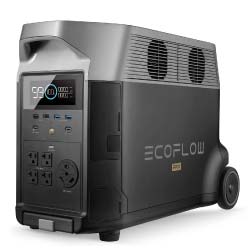
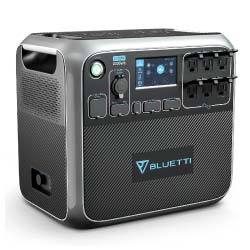
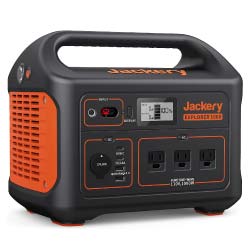
List of The Best Solar Generators for Refrigerators
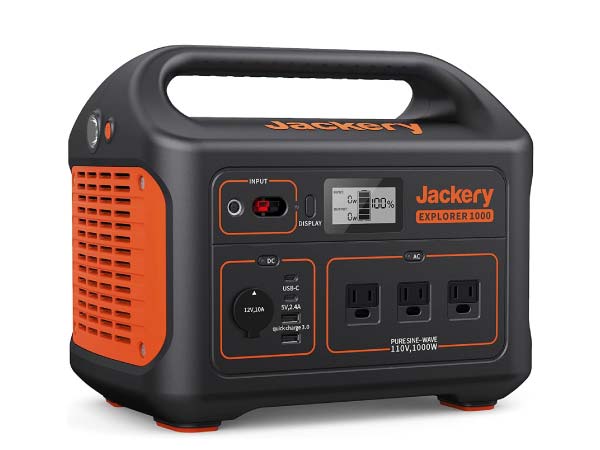


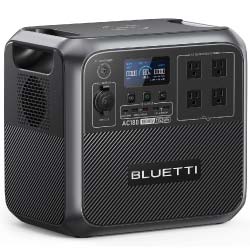
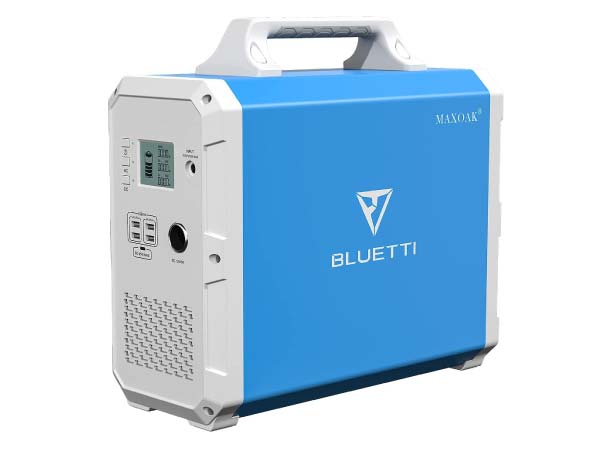
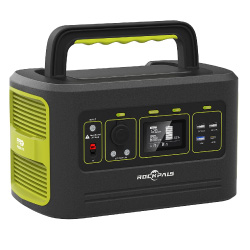
How Did We Find The Best Solar Generator for Refrigerator?
I and my team tested 21 power stations, interviewed 6 professionals who are currently working in different solar generator manufacturing companies, talked to 13 pro outdoorsmen about their views, and gathered plenty of data from online forums to finalize the top 6 best solar generators for refrigerators.
Refrigerator Wattage You Need to Know
Following is the general power rating of the different refrigerators available in the market.
| Refrigerator | Wattages |
|---|---|
| Portable Mini-Refrigerator | 30 to 35W |
| Energy Star Refrigerators | 35 to 100W |
| 10 to 15 cu ft. Refrigerators | 280 to 300W |
| 15 cu ft. free Refrigerators | 330W |
| 20 cu ft. Chest Refrigerators | 350 to 450W |
| 16 to 18 cu ft. frost-free refrigerators | 400W |
1. Jackery Explorer 1000 – Best Portable Power Station For Refrigerator
FEATURES & SPECS

I have written a detailed review of the Jackery 1000, but this review will be more of a summary.
Jackery Explorer 1000 is one of if not the best portable power stations on the market in the 1000-watt range.
It can easily run a standard 200-rated, and 1200-peak watts refrigerator for hours.
Explorer 1000 is virtually noiseless, unlike those noisy portable generators.
The design of this thing is super sleek, portable, and lightweight which makes it an ideal power station for Overlanding, camping, and RV life.
A collapsible handle on the top would’ve been best to save even more space in the back of the truck, but I don’t have standard carry handles.
It has a whopping 1002Wh battery capacity with 3 pure sine wave AC outlets to power sensitive appliances like cellphones, laptops, cameras, drones, and mini coolers.
Jackery 1000 has 2000 watts of surge power which is crucial if you are going to run a fridge that can surge up to 1200 watts. I only use Dometic 28 mini fridge on Jackery.
This portable power station is loaded with ports:
- 3 pure sine wave AC outlets
- 1 DC power input
- Anderson Power Pole port
- 2 USB-A ports
- 2 USB-C ports
- DC outlet
So there are three ways you can charge this unit. Solar, AC wall outlet, and DC charging.
I am a little disappointed with the solar charging. It can only accept 200W of solar input which is not ideal for a 1000-watt power station.
So according to my test, on a bright sunny day, Jackery 1000 will take up to 8 hours to fully charge using two SolarSaga panels of 100W each.
It will take close to 7 hours to fully charge using the AC wall outlet.
And lastly, it will take up to 13.5 hours to fully charge using the DC car outlet. I normally use my power station to power my mini-fridge while it charges from the DC car outlet.
The solar generator can be used between 46 to 48C temperatures. I have tested that.
The BMS Jackery is top-of-the-line. It doesn’t eat much battery. I have been able to charge my drone batteries, cellphone, iPad, laptop, camera battery, and Dometic 28 mini fridge regularly.
Load Test: The reason Jackery 1000 is an elite power station is it can provide as much power as advertised.
During the load test, I was able to get 1090 running watts without tripping the overload alarm.
Its inverter is close to 96% efficient.
According to my test, Explorer 1000 will be able to charge the following devices:
- Laptop = 9 charges
- Cellphone = 100 charges
- Coffee maker = 50 mins
- TV = 13 hours
- Microwave = 45 mins
- Mini Cooler = 17 hours
BEST FOR: Jackery Explorer 1000 is best for Overlanding, camping, RV use, and travel trucks due to its sleek, lightweight, and compact design, and 1000 running watts. It can also be used as an emergency backup source.
2. Bluetti AC200P Portable Power Station – Best For Freezer
FEATURES & SPECS

Bluetti AC200P is the juggernaut of 2000-watt power stations. This thing is an absolute beast loaded with modern features.
We have a detailed review on the Bluetti AC200P too.
This thing is made for outdoor and camping use, but 70% of the people that I know are using it for residential use. It is a perfect power station to run your standard or mini-fridge 24/7.
It is rated at 2000 running watts and 4800 surge watts with a whopping 2000Wh battery capacity. This much power is more than enough to run home essentials.
AC200P features an ECO mode as well to save power and reduce noise when the attached load is low. It is backed by a 2-year warranty.
It is based on a highly advanced LifeP04 battery composition. You can learn more about battery chemistry in this research.
It is not a lightweight power station and most campers will find it difficult to carry this thing on foot, but the design is pretty sleek, compact, and beautiful. Hard plastic is used for construction. Two handles are molded into the frame to lug it around.
The best thing about the whole design is the touchscreen panel. I love that Bluetti listened to us and installed an LCD that shows input/output power, temperature, battery stats, battery remaining, current, and other essential information.
This thing is loaded with AC and DC ports.
- X6 110V AC ports.
- X1 12V 10A DC.
- X1 12V 25A DC.
- X1 12 3A DC.
- X4 USB A outlets.
- X1 USB C port.
- 2 wireless charging ports.
- X1 PD 6OW fast charger outlet that accepts 5V/3A, 9V/3A, 12V/3A, 15V/3A, and 20V/3A charging.
There are multiple ways to charge Bluetti AC200P including solar, AC wall outlet, car, and solar+wall.
It can accept a maximum of 700W, 35 – 50V, and 12A of solar input. MC4 to XT90 connection is used.
During my tests using a 600W solar setup, it took 4 hours to completely charge the unit.
Using an AC wall outlet, the unit will take 4 to 5 hours to completely charge. EcoFlow Delta Max 2000 takes under 2 hours to fully charge using X-Stream fast charging technology. Bluetti AC200P needs to step up its game. EcoFlow is beating it in the charging department.
If I compare it with its closest competitor EcoFlow Delta Max which under 2 hours to fully charge using X-Stream fast charging technology, Bluetti needs to step up its game. EcoFlow is beating it.
Using CAR charging, it takes about 8 to 9 hours using 24V input which is impressive. I normally run my Mini fridge while it charges.
Solar + wall is the fastest way to charge this unit. I normally use 650W of solar input when I am at home, and 411W of AC input, the device takes 2.5 hours to fully charge.
Let’s talk about its performance. It can operate between -2C to 48C, the power efficiency is close to 88%, and it will run all the devices that are rated at or below 2000 running watts.
I have run my mini-fridge for 26 hours straight without recharging.
The only complaint I have is the inefficient BMS (battery management system). BMS consumes a lot of charging just to stay on.
Load Test: I have conducted a load test three times.
- I managed to scrap 2010 watts off of this power station when I purchased it during the load test.
- After 11 months of use, I managed to scrap 2002 running watts.
- Now after 12 months of use, the device gave 2008 running watts.
It passed the load test all three times with flying colors.
According to my load test, Bluetti AC200P will charge the following devices:
- Cellphone = 170 to 180 charges
- Laptop = 25 to 30 charges
- Mini fridge = 25 to 28 hours
- TV = 15 to 20 hours
- 100W projector = 15 to 20 hours
- 8000BTU AC = 5 to 7 hours
- Coffee maker = 5 to 70 hours
- Hair dryer = 70 to 75 minutes
BEST FOR: It is best for home usage, outdoors, and on RVs. It also works for people who are looking to purchase an emergency backup power source. It can easily run a mini-fridge for 25 to 28 hours straight.
Checkout Full review of Bluetti AC200P Portable Power Station
3. EcoFlow Delta Pro Solar Generator – Best For High Wattage Refrigerators
FEATURES & SPECS

EcoFlow Delta Pro is one of if not the best solar generators for refrigerators available today. It is spectacular in every way. It is made of complete off-grid operation.
Delta Pro is equipped with a 3600Wh battery with a whopping 3600 running watts and 7200 surge watts. This much power is enough to run Samsung 28.2 cubic feet French door refrigerator for 44 hours without solar charging.
You can double the power output up to 7200 watts by connecting two delta pros with a single cable.
The biggest selling point for me is that we can power 240V loads by connecting two Delta Pros.
During my tests, I came to know that this power station is 93.4% power efficient which is insane. I have powered two pressure washers at the same time without any problem.
X-BOOST feature allows this unit to deliver 4500 watts for a short time if needed. I used this feature on my small electric dryer.
The reason I am using it as an off-grid power system is due to battery expansions.
You can now connect two 3600 watts of delta pro battery expansions with the Delta pro using two ports on the back. All three units will charge and discharge simultaneously.
With a 3.6KWh battery, this thing should’ve been heavy, but it is not. It weighs only 99 pounds measuring 25 x 11.2 x 16.4 inches. I find it very compact for RV usage.
The LCD screen control panel shows a bunch of information including input/output power, outgoing power from 12V receptacles, battery stats, and error codes. The LCD has an ambient light detector is a nice feature.
EcoFlow Delta pro is absolutely loaded with AC and DC ports. You can literally power any device.
| Ports and Outlets |
|---|
| X2 USB-A fast charging ports |
| X2 USB-A ports |
| X2 USB-C 100W ports |
| X5 AC output outlets |
| Solar Charging Input |
| One Anderson power port |
| Car outlet |
| AC Charging Input |
There are multiple ways you can charge this device, but I will only the ones I have personally tested.
I have a 1600W, 150V solar array system, and using that system Delta pro and two expansions were charged from empty to full in 6.7 hours. All three were charging at the same time.
I often use an AC wall outlet to charge Delta pro as well because it has X-Stream fast charging technology. I took readings while it was charging on four different occasions.
- It took 2.7 hours to charge from 0 to 100% in the first attempt.
- It took 2.7 hours to charge from 0 to 100% in the second attempt.
- 2.65 hours to charge from 0 to 100% on the third attempt.
- 2.7 hours to charge from 0 to 100%. On the fourth attempt.
You can also charge Delta pro from the EV charging station. It can receive up to 3000 watts of AC input. I have only tried this method once. I was receiving 2315 watts from my nearest EV charging station my power station was full in no time.
I have tested EcoFlow delta pro’s power by running the following refrigerators.
| Refrigerator Mode | Energy Consumption (KWh/year) | Daily Energy Consumption (Wh) | Delta Pro usable hours without solar | Delta Pro usable hours with solar |
|---|---|---|---|---|
| Samsung 28.2 cu.ft. French door refrigerator | 645 | 1767 | 44 hours | No limit |
| LG 26 cu.ft. 3 door refrigerator | 708 | 1940 | 40 hours | No limit |
| GE 27.7 French door refrigerator | 725 | 1986 | 39 hours | No limit |
| Whirlpool 28 cu.ft. side-by-side refrigerator | 747 | 2047 | 28 hours | No limit |
Powering a 5000 BTU AC, mini-fridge, and other daily life appliances is not a big deal for this power station, but the real magic happens when you connect two expansion batteries to it and go completely off-grid.
Load Test of EcoFlow Delta Pro: When I purchase this solar generator for refrigerator and home use, I quickly conducted a load test. I was able to get 3621 running watts.
Since then, I have conducted a multiple load test in different temperatures and scenarios, and each time it passed the test.
I can safely say that EcoFlow Delta Pro is the best solar generator for refrigerators.
BEST FOR: EcoFlow Delta Pro is for off-grid operations and people who want a solid backup power source that runs each and everything in their home.
Checkout Full review of ECO FLOW delta Pro
4. Bluetti AC180 Power Station
FEATURES & SPECS

This portable power station has proven to be a versatile and reliable companion for various situations, from outdoor adventures to emergency backup power. In this review, I’ll break down its features, performance, and overall usability in a user-friendly manner.
The Bluetti AC180 is the younger brother of the AC200P, with an 1152Wh battery capacity, 3500 lifecycles, and a whopping 1800W power output. This power station was introduced to fill the gap between 1000 and 1500 watts.
The 3500 cycles are rated at 80% capacity, which is not bad. Unlike the higher-priced Bluetti, this power station doesn’t feature a touch screen. The inverter is rated at 1800W with four AC 20A outlets.
The build quality of this unit is excellent. It is made of durable plastic. The dimensions are sleek, it weighs only 16 kg, and there is a wireless charging pad on the top. It is super portable and lightweight.
It is perfect for outdoor activities and even solo camping.
Battery Capacity Test: As we always do at my garage, we conducted a double battery capacity test for AC and DC output four times. Here are the results.
- AC OUT: The result of the AC battery capacity test was an average of 1030/1152Wh, or 89%.
- DC OUT: The result of the DC battery capacity test was 1039/1152Wh, or 90%.
These numbers are outstanding. The newer Bluetti products are performing really well compared to the older ones.
The better DC numbers are because they removed the high DC output circuitry and touch-screen panel that they had on the AC200P. That saves a lot of power.
PASSED THE CAPACITY TEST
Inverter Capacity Test: We pushed the inverter to its absolute limit, and we got around 2400 watts for a
few seconds before the inverter shut down. Not too bad at all.
PASSED THE INVERTER CAPACITY TEST
Sine Wave Test: The sine is also perfect. We pulled around 120V at 60 hertz.
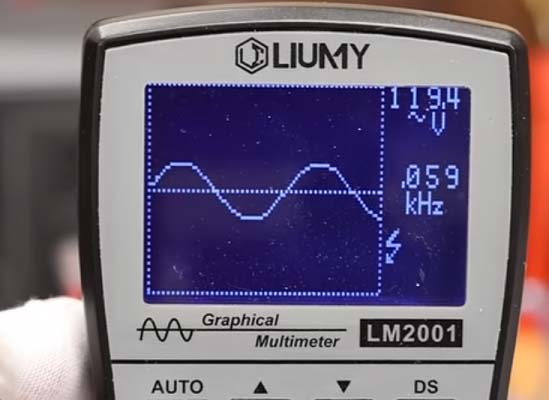
PASSED THE PURE SINE WAVE TEST
Overload Test: Bluetti AC180 is only an 1800-watt inverter, but we started the test at 2000 watts just to see if it lasted for 5 minutes.
After 2 minutes, the generator shut down. Not bad. I performed the overload test at 1900W, and surprisingly, it also lasted for 2 minutes.
Finally, we started the test again at its rated 1800 watts, and it ran for 5 minutes with no problem at all.
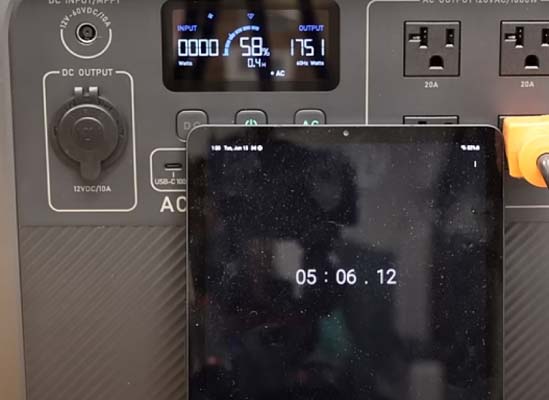
PASSED THE LOAD TEST
Charging: It has four charging modes: AC, DC, SOLAR, and USB. Of course, we are going to test all of them.
#1. AC Charging:
The first one we tested was AC charging with max turbocharging mode. It also has a normal mode, but we went straight for the turbo one.
We pushed around 1450 watts into it, and it took around 42 minutes from 0 to 80%. The turbo mode is a bit noisy, which is understandably so. It will take around 1.2–1.3 hours to fully charge this unit.
#2. Solar Charging/DC Charging:
First of all, don’t charge it out in the sun; it will eventually overheat, the BMS system will trigger the safety features, and the power station will power off.
From 52%, it showed that I had about 1.2 hours left to charge it completely, and the total input was 400 watts. It supports a maximum of 500 watts, so don’t exceed that.
#3. Wireless Charging:
The wireless charger is designed to provide 15 watts of DC power, so I tested it on my phone. But it only supplied 10 watts, and it took around 2 hours to fully charge my phone.
It doesn’t support fast charging, but for a power station, I don’t have any complaints.
#4. USB Charging:
It also has a 100-watt USB charging output. It won’t charge the power station if you are confused.
I had my power band hooked up, and Bluetti AC180 was supplying 94 watts into my power band. There is always a loss of a couple of watts, so it does support USB charging.
Key Takes:
- It passed all the main tests, including the battery capacity test.
- It also passed the pass-through charging test as well. It only takes 20 milliseconds to change the power from the wall outlet to the power station’s battery.
- It is back to the basic, good old-fashioned power station with all the nice features and a massive 1800-watt inverter.
- Some of the drawbacks are that it misses the 25-amp DC outlet and 30-amp RV hookup that the AC200 series had. It only has one USB-C port.
5. MAXOAK Solar Generator for Refrigerator – Best For Mini Fridges
FEATURES & SPECS
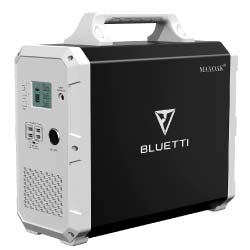
MAXOAK Bluetti EB150 is a budget-friendly, high-capacity, portable, and reliable solar generator that is mostly preferred for powering mini-fridges.
1000 running watts and 1500Wh capacity are more than enough to power the Dometic 28 mini-fridge for days.
The reason it is considered a better Bluetti power station than Bluetti AC200P is the high-quality MPPT controller and BMS. Unlike AC200p, MAXOAK’s BMS doesn’t eat much charge just to stay awake.
MAXOAK is known for producing high-quality devices since 2009. I am using this unit for almost a year now and I am a huge fan MAXOAK’s manufacturing prowess.
I love the design. It is built like a small suitcase with a handle on the top. The dimensions are compact which makes it ultra-portable for camping and Overlanding. The device is covered with a strong aluminum case. Air vents are on the bottom. This device doesn’t get much hot.
The ports and LCD are on the front panel. The LCD control panel displays input/output power, battery stats, and error codes.
Speaking of ports, MAXOAK EB150 consists following outlets:
- X2 1000W AC ports.
- X3 USB ports 3A.
- X1 45W USB-C port.
- X1 12V 9A DC car outlet.
- 16 to 60V 10A solar /DC input port
- AC ON/OFF switch
- DC ON/OFF switch
So MAXOAK only has two charging options, solar and AC wall outlet. I would’ve loved 12V car charging as well because I loved to power my DOMETIC 28 mini-fridge while driving and charge the power station simultaneously. That is why I take JACKERY 1000 with me.
However, this thing can accept a whopping 500W of solar input. According to my test, the device was full in 3.1 hours at 489 watts of solar input. I don’t have any complaints.
At 160W of AC input from the wall outlet, this unit takes about 9 hours to fully charge. Not super impressive, but not bad at all.
I compared the reading I took using my wattmeter with MAXOAK’s LCD, both were similar.
So according to my tests, the inverter of MAXOAK is about 94.99% efficient. It produces a pure sine wave.
I love that this thing is loaded with different AC and DC ports. I have been able to power the following things:
- Laptop = 9 charges
- Cellphone = 90 charges
- Coffee maker = 40 mins
- TV = 13 hours
- Microwave = 40 mins
- Mini Cooler = 15 hours
MAXOAK is best suited for following refrigerators according to my tests.
| Refrigerator | Running Watts | Starting Watts |
|---|---|---|
| Mini-Fridge | 50 | 200 |
| Standard Mini-Fridge | 75 | 300 |
| Big Mini-Fridge | 100 | 400 |
| Standard Energy Star Fridge | 132 | 528 |
| Big Energy Star Fridge | 192 | 768 |
Load Test MAXOAK Power Station: So I conducted a few tests. At 1100 input power, and 1050 output power, the inverter lasted for 3 minutes. 95% efficiency. At 900 watts, this device lasted for 1 hour and 15 minutes.
It passed the load test, and the efficiency of the inverter is close to 95%.
BEST FOR: If you want a portable power solution for camping and RVs to run refrigerators and small devices, MAXOAK EB150 solar generator is for you.
6. ROCKPALS 600W Portable Power Station
FEATURES & SPECS

ROCKPALS 600W is a very slick-looking power station with a whopping 614Wh capacity and LifePO4 battery chemistry that can give 3000+ life cycles. It is 12V regulated.
When I got my hands on this little bad boy this February, I thought the design is pretty similar to Jackery, but it is not. The handle on the top can collapse which makes the surface completely flat. It makes the unit extremely camping and RV-friendly.
It is made of 1200D high-density textile material which not only makes it super strong like HULK, but it can withstand foggy and wet conditions as well.
When ROCKPALS send me their 600W portable power station, the first thing on my mind was to test its BMS because they say it has:
- Overcharging protection
- Over-voltage protection
- Over-power protection
- Over-discharge protection
- Short-circuit protection
I found that it doesn’t lose its charge in cold, and hot temperatures. Compared to Bluetti, it has a very efficient BMS (battery management system).
So I took it on a little 3-day camping trip in the woods. I was powering a mini-cooler, a drone, a navigation device, a laptop, and lights with this thing.
I found that ROCKPALS 600W can keep the mini-cooler running for 12.5 hours on a single charge which is more than the advertised 12 hours. I was able to boil water using an electric kettle as well.
There are a ton of AC and DC ports on this little bad boy. Some of them are:
| Ports and Outlets | Voltages and Wattages |
|---|---|
| X1 solar charging port | 12 – 26V, 120W |
| X1 DC output | 12V, 5A, 60W |
| X1 DC input | 65*30mm, 11 – 26V, 96W |
| X2 USB-A ports | 5V, 3.1A. 5 – 12V, 18W. |
| X1 3.0 quick charge port | 18W max |
| X1 AC output | 3*110V, 600W, 1000 peak |
| X1 Carport | 12V, 10A, 120W max |
There are 6 different charging methods. Solar panels, AC wall outlet, car port, solar generator. 6 combinations can be made using these methods.
I have only used a few charging methods. Using a 120W Anderson solar charging port, ROCKPALS 60 watts only took 3.1 hours to charge from 0 to 80%. I was using Rockpals 100W solar panels.
Using DC (96W) AND USB-C PD (60W) at the same time, this unit only took 3 hours and 35 minutes to charge from 0 to 80%.
I am satisfied with the charging speed and methods. For a 600W unit, 3 to 4 hours is a standard.
I ran the following devices with ROCKPALS 600W Portable Power Station
| Device | Wattage | Charges |
|---|---|---|
| Phone | 11Wh | 51 charges |
| Laptop | 60Wh | 10 charges |
| Light | 5Wh | 99 charges |
| CPAP | 40Wh | 13.4 hours |
| TV | 110Wh | 5.2 hours |
| Mini-Fridge | 60Wh | 9.2 hours |
| Camera | 10Wh | 54 charges |
| Electric Stove | 580Wh | 1.2 hours |
| Drone | 40Wh | 13.5 charges |
So the ultimate test of ROCKPALS 600 watts was to run the following refrigerators that I ran with MAXOAK Bluetti EB150.
| Refrigerator | Running Watts | Starting Watts |
|---|---|---|
| Mini-Fridge | 50 | 200 |
| Standard Mini-Fridge | 75 | 300 |
| Big Mini-Fridge | 100 | 400 |
| 0 Standard Energy Star Fridge | 132 | 528 |
It ran all the refrigerators mentioned above.
Load Test of RockPals 600W Power Station: This thing is rated at 600 running watts. I tested the power output four times.
- 603 running watts in the first attempt
- 602 running watts in the second attempt
- 602 running watts in the third attempt
- 604 running watts in the fourth attempt
This solar generator passed the load test with flying colors.
Due to its lightweight and compact dimensions, Rockpals is purely made for outdoor usage. Whether it is RV camping, fishing, Overlanding, or camping in general, I can vouch for this device if your load is under 600 watts and if you want a device that changes rapidly.
BEST FOR: Rockpals 600W power station is the best solar generator for RV camping, Overlanding, fishing, and general outdoor activities.
Can a Solar Generator Power a Refrigerator?
A solar generator can power a refrigerator. However, you have to consider how much starting and running watts your refrigerator consumes, and how powerful your solar generator is. A mini-fridge consumes 50 running watts and 200 starting watts, and a solar generator with 2000Wh capacity like Bluetii AC200P can run the refrigerator for 25 to 28 hours.
For Example, You have a 50-running watt mini-fridge on a solar generator 24/7. However, the cycle turns ON and OFF so the fridge is running for only 8 hours.
Here is the detailed guide on “What size generator do we need to run a refrigerator?”
50W X 8 hours = 400Wh
We also have to consider starting watts as well, so get a 600Wh solar generator or higher to be on the safe side.
Buying Guide for the Best Solar Generator for Refrigerators
There isn’t a lot of data available online about solar generators specifically for refrigerators. So we took this task into our own hands and found the top 6 models that are currently best for refrigerators.
Before you make a purchasing decision, make sure you check out the following things.
Battery Capacity:
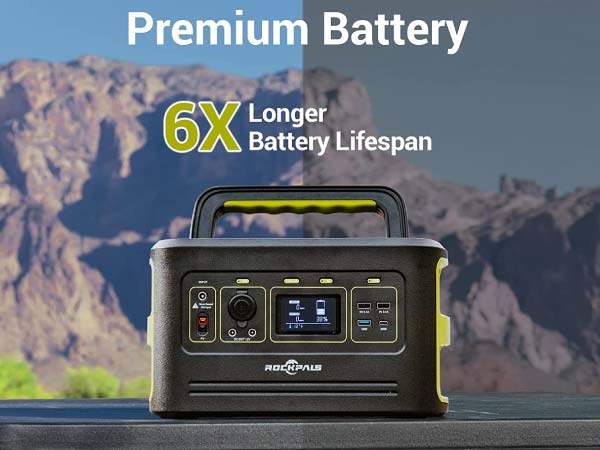
If you want to run a mini-fridge of 50W, you would at least need a 600Wh power station because refrigerators need extra power to start (Starting watts).
Battery capacity (Watt-hour) depends on how big of a fridge you want to run, and how much you are willing to spend.
A 1000Wh power station like Jackery Explorer 1000 is a bit expensive, but it will be able to run mini-fridges for a long period along with lights, laptops, coffee makers, microwaves, and cellphones.
So if you can afford and want to run other things besides a refrigerator, get a unit that is close to 1000Wh.
Power Output:
A refrigerator is a motor-driven device that needs extra power (stating watts) for a moment to start to overcome inertia just like an AC, microwave, and other motor-driven devices.
So it is essential to get a power station that has enough running and starting watts to cover the initial power requirements of a refrigerator.
Suppose you want to run a 50W mini-fridge that requires 400 starting watts. You would need a solar generator that has at least 500 running watts, and 800 starting watts capacity to run a mini-fridge and other small appliances smoothly.
AC and DC Ports:
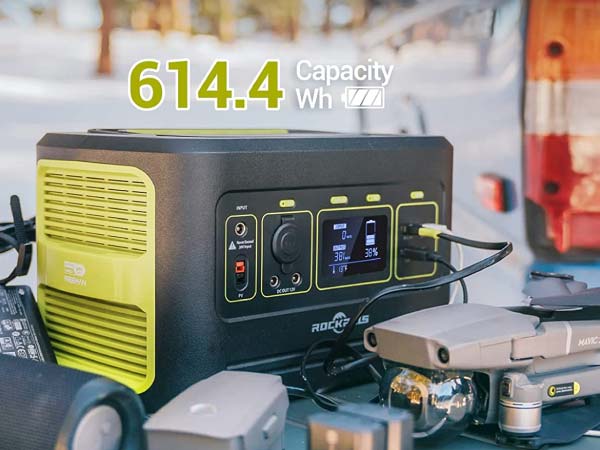
Being an outdoorsman, I want my power station to have a few pure sine wave AC ports, a couple of low voltage AC ports, some DC ports, and some USB ports to power and charge a mini-fridge, camera batteries, drone batteries, laptops, cellphones, a coffee maker, a microwave, an electric heater, and few LED lights.
Even if you are not an outdoorsman or an occasional camper, you won’t regret having a lot of different outlets in your power station.
Fast Charging and Low Discharge Rate:
Some power stations like EcoFlow Delta Pro take no time to charge and you would want to get your hands on those models to save some time. Campers like me appreciate this quick charging.
Fortunately, all the power stations on our list offer a quick charge feature.
Most power stations don’t mention discharge rates in their user manual but it is important to know this detail. You want your unit to lose its charging at a crazy pace without even putting any heavy load on it.
I have only listed those models that have a very low self-discharge rate.

Alex Black is a seasoned electrical engineer with a remarkable 8-year track record specializing in appliances, generators, and transfer switches. With extensive hands-on experience in the field, Alex possesses a deep understanding of electrical systems and their intricate workings. Throughout their career, Alex has consistently demonstrated expertise in designing, troubleshooting, and maintaining various electrical appliances.
